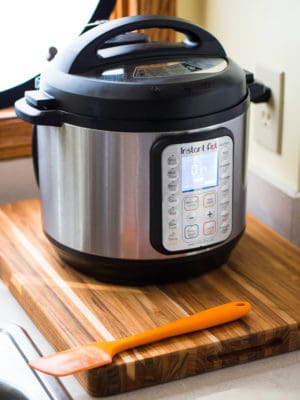Would you like to save this recipe?
When I did the quick release I got a starchy spew with the steam that was released. Should I have let it rest a bit?
Short answer: Yes, you should let it rest a bit!
Longer answer:
I get the “quick release is spraying more than steam” question from time to time. It’s usually from my Macaroni and Cheese recipe - more on why that is in a minute - and most of the other times are from a bean recipe.
It happens to me too! Most of the time with these recipes, a quick release just releases steam. But, sometimes I get more than steam - the pressure cooker starts spitting and sputtering, and I get a mess - a fine mist of the food spraying out with the steam.
Q: What should I do when my Instant Pot quick release is spraying starch?
A: Carefully close the pressure release valve, let the pressure come down for five minutes, and try again. Carefully! The steam (and the spitting liquid) are pressure-boiling hot. Protect your hands with a towel or an oven mitt. When you try again after five minutes, the vent will spit a little bit - that’s normal, as it clears out the valve. But, if it keeps spraying stuff, repeat the process - close the valve, wait five more minutes, then try again.
It may take a few tries to get a clean pressure release. It depends on how hot the pot still is. If I'm impatient, I'll keep trying to quick release every five minutes. If I have other things to do, I’ll give up, turn off the pot, and wait for the pressure to come down naturally.
Q: What’s going on? Is my pressure cooker malfunctioning?
A: No. This sometimes happens when you quick release a pressure cooker.
A couple of things could be happening when the valve is spraying more than steam:
- Releasing the pressure throws the liquid to a heavy boil. Pressure cooking works by increasing the boiling temperature in the pot. Under pressure, the water gets hotter before the boiling air can escape. Quick releasing the pressure reverses that process - the drop in pressure makes it easier for the air to escape, so the contents of the pot will spring to a boil. If the pot is full - right up against the max fill line - it may be close enough for the boiling to reach the vent.
- The contents of the pot are foaming. Foaming happens with starchy ingredients, like pasta, beans, grains, and potatoes. Starch mixes in with the liquid, and the boiling bubbles get stronger and less likely to pop. If you had a boil-over on a regular stove, you’ve seen this happen. The bubbles start foaming, stacking up on each other, and build up until they get too heavy and collapse on themselves...or they overflow the top of the pot. The same thing is happening inside the pressure cooker, but it is trapped inside by the sealed lid.
Spraying food is usually a combination of both - a sudden, heavy boil of starchy liquid. The result is a boil-over, like on a stove. But the boil-over can only escape through the pressure valve in a messy spray.
The workaround is the same as on a stovetop boil-over. Reduce the heat and the boil will come down. Unfortunately, we’re dealing with a sealed pot. It takes time to cool down before we can try again.
The other solution? Take preventative measures, and don’t have a boil-over in the first place. There are three ways to avoid it:
- Don’t quick release, let the pressure come down naturally. A natural pressure release will not boil over, because you never open the valve. (Also, you don’t have the vigorous boiling, which is easier on the food in the pot.) When I can, I go the natural pressure release route, but some recipes need the quick release to avoid overcooking.
- Don’t fill the pot more than ⅔rds full: The max fill line on pressure cookers is ⅔rds of the pot. The max fill gives the pot headroom - it has to have space to build up steam so it can build up pressure - but it is also there to keep boil-overs from happening. Don’t try to fit “a little bit more” into the cooker. (Note: I’m saying this as much for myself as for the readers. I always want to add a little too much water to my chicken broth recipe.)
- Don’t fill the pot more than ½ full when cooking starchy foods: Almost all pressure cookers have a max fill recommendation of ½ the pot for foamy foods like beans, peas, pasta, and other starches. The extra headroom helps keep the foaming away from the pressure release valve. (Note: I’m also not good at this one - but I’ll try to use rule #1 and not quick release when I’m cooking foamy foods.)
What do you think?
Questions? Other ideas? Leave them in the comments section below.
Related Posts
Instant Pot FAQ
How to fix Instant Pot Overheating
Instant Pot as a Slow Cooker?
My other Pressure Cooker Recipes
Enjoyed this post? Want to help out DadCooksDinner? Subscribe to DadCooksDinner via eMail and share this post with your friends. Want to contribute directly? Donate to my Tip Jar, or buy something from Amazon.com through the links on this site. Thank you.






Brian says
Thank you for this. I had spitting liquid when I did a release on my WMF 4.5 litre pressure cooker. I had let it sit off-heat for 10 minutes, thinking that that was enough for the natural release. (Ten minutes is always fine for my Lagostina 9 litre pressure cooker.) In the WMF, I was cooking chickpeas and I had forgotten about the starch issue. So, I let it sit for another 10 minutes off-heat and it was fine when I did the release. I'm glad I've found your article; thanks again.
Mike Vrobel says
You're welcome!
Sherry Paciorek says
when I want to make chicken soup, the water and steam start spitting out even before I touch the release button, is the rubber gasket worn out, what should I do! Please help because I really enjoy using my instant pot
Mike Vrobel says
Maybe the gasket is worn out, maybe it is overpressurizing, or maybe something else is wrong. Contact Instant Pot support at https://www.instanthome.com/contact-us and see if they can help.
Laura J. Holcomb says
Thank you! Thank you! My husband and I are vegetarians and we absolutely love our Instant Pot. But, I didn't like the black bean juice that appeared on my kitchen wall when cooking black beans in the Instant Pot. It wouldn't come off with scrubbing so I ended up priming and repainting my kitchen walls. And, I certainly don't want to do do that every time I make black beans! So thank you and thank you again!
Time for some black bean chili!
KRISTEN says
Glad I found this....I have had it happen 4 times now with noodles for Mac n Cheese. I will try doing a natural release but.....Im concerned my noodles will be over cooked. Should I decrease the cooking time if I am going to do a natural release? My noodles are gluten free (most of the time) and be be temperamental and turn to mush.
Mike Vrobel says
I can't say. I've never cooked with gluten free noodles.
Jane Anderson says
Thank you! I filled my split pea soup with a ham bone so it was too full. Didn't want to lose my soup out the vent. 2nd time it worked--no spewing. Lots to learn. Appreciate those like you who know more helping us out.
Lisa says
Release in quick bursts for a minute or so. I did this with my Mac and cheese and it didn’t overlook the pasta.
Razzy 7 says
You're right, it's no fun to have the pressure cooker release that starchy, messy spray and as long as the food won't overcook by waiting another 5 minutes to release the pressure, that's what I do - WAIT.
But sometimes I want to release the pressure immediately to avoid overcooking, so I throw a dish towel loosely over the lid, covering the vent as soon as I vent the pc. The dish towel probably will get messy but it's no big deal.
Ted says
I do the dishtowel thing too, and just assume it's going to spit.
Patrick Chin says
We cover up the release valve with a dish towel as well!